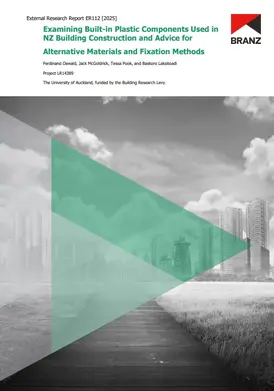
ER112 Plastic waste in construction Report 5 - Fixation methods (May 2025)
Product Description
This research examined the plastic components procured for a case study building construction site in Auckland and other commonly used plastic building components. Each component was evaluated in terms of potential for reuse, recycling and landfill using the expertise and information from builders, architects, product manufacturers and building companies. The information was compiled and formatted to be integrated into the LCAQuick C1 Building End-of-Life Waste Datasheet. Glues and foams were one of the focal points of this report, as they have a wide variety of applications in building construction.
In conclusion, this report evaluated relevant plastic components and fixation methods found in New Zealand residential buildings. Based on cost estimate documents from the case study site of eight terraced houses at 40 Titirangi Road, a comprehensive list of plastic components used in a typical residential building construction project in Auckland was generated. This report highlighted the linear nature of the life cycle of fixation methods commonly used today. Five building component systems and materials that disregarded the end-of-life of a building were selected and alternative fixation methods and materials were identified. These examples were formatted for integration into LCAQuick Module C1 through a detailed breakdown of each component system or material. Potential alternatives conducive to a circular economy were found in historical approaches such as the range of mechanical fastenings that were widespread before the use of glue and foam adhesives in New Zealand. Minimising the use of glues and foams allows for better separation at the end of life and, consequently, more effective recycling and reuse opportunities for materials and components.
Product Information
| Publication date | May 2025 |
|---|---|
| Author | Ferdinand Oswald, Jack McGoldrick, Tessa Pook and Baskoro Laksitoadi |